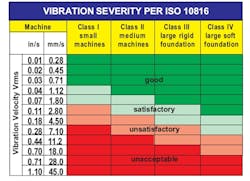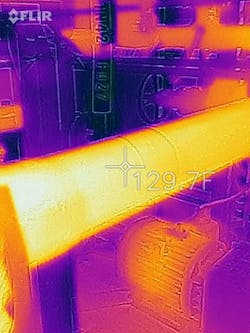Predictive maintenance primer: Transitioning from a reactive to proactive state
Predictive maintenance (PdM) is an impressive element of modern maintenance. It’s part science, part art and, given that practitioners can see through metal to predict the future, part black magic!
Starting a PdM program at your plant fortunately is not a question of sorcery. As is often the case, Pareto applies to investment costs and returns: 20% of the technology can yield 80% of the benefit. All you need is this short primer that covers three basic areas: vibrations analysis, oil sampling, and thermography.
1. Vibration analysis
Vibration analysis is the most popular technique within PdM. A broad range of rotating machinery failure modes can be diagnosed, and therefore addressed, before a breakdown occurs. For new PdM programs, the sheer variety of analyzer equipment options can be very intimidating. The best advice for an immediate return on investment is to start small.
A simple handheld overall vibration meter can provide trending data that is easy to understand and only runs around $2,000. Evaluating results doesn’t require a Ph.D. from Hogwarts, either. ISO 10816, shown below, provides simple criteria that are effective for predicting breakdowns. Higher end analyzers can indicate what the specific failure mode of the breakdown may be, but they come with a significantly higher price tag. If that additional insight is of marginal importance for your typical application, the cost is difficult to justify. Save money and keep it simple.
2. Oil analysis
Oil analysis is another popular PdM technology that can be beneficial even at a low price point. Tribology (and no, this is not another Harry Potter reference) is a powerful field of study that can provide early warning of mechanical failure in oil-lubricated equipment such as gearboxes and bearing housings. Small concentrations of ferrous wear particles, for example, may be invisible to the naked eye. Oil analyses can detect this tell-tale sign of metal- on- metal contact well before obvious symptoms are noticeable.
Rather than buying expensive equipment and hiring a specialist to use it, which is likely cost- prohibitive for smaller facilities, roll -out your program with a third- party service. Individual samples can be analyzed for about $25 each, including sampling equipment and shipping. Reports are comprehensive, designed for non-experts, and require no formal training to interpret. The main drawback is that results take a few days to process, where in-house analysis is done the same day. That’s typically an acceptable trade-off for an inexpensive evaluation that will provide your facility with proven predictive ability.
3. Thermography
Thermography is a third technology that can be implemented at a low price point and with minimal training. Two attractive options are easily accessible. The first option is to outsource a professional thermography analysis. Compared to vibrations and oil sampling, this type of study can run considerably higher depending on scope. On an annual basis however, the cost may be easier to justify, particularly for equipment like electrical infrastructure where there just aren’t many other predictive technologies available.
A more economical option is to buy a high-quality temperature scanner. Flir, for example, has an excellent camera that plugs right into a smart phone, which is also convenient for taking pictures. Data is simple to interpret and, even if you don’t ever predict a thing, you’ll be happy to have one of these scanners for everyday troubleshooting. One thing is certain: a hand-held temperature gun won’t collect dust.
Tying it all together
For any of these methods to be successful, there are some simple steps to follow. First, always take measurements at the exact same location. It can be surprising how much readings can change from point to point on a machine.
A second key to PdM is to focus on change rather than absolute readings. Equipment baseline levels are practically as unique as fingerprints. Trend data to identify step changes, and you’ll be successful. Cross-reference data from different technologies, for example oil trending and vibrations on the same machine, to get the most out of your program.
Last, make sure that your maintenance department workflow is healthy. PdM is only effective if carried out at regular frequencies and with appropriate follow-up. That means that a PM needs to be in the CMMS to be worked according to schedule. After completing the work order, it is important that the PdM results are used to generate corrective actions, otherwise it’s not working.
PdM has an aura of black magic to it that is a bit overblown. The recommendations in this primer come with a low price tag and require no special training. Implemented properly, these represent 20% of the costs and 80% of the benefit. There’s no overstating how important PdM is to transitioning from a reactive to proactive state. So crank out that credit card and start collecting data - there’s no telling what you’ll find.
About the Author

Alex Ferrari
Alex Ferrari, CMRP, is a Maintenance Manager of a specialty cosmetics manufacturer in Charlotte, NC. He has worked in the chemical and nuclear industries both in the US and abroad in Argentina. As a blogger and as a maintenance professional, Alex aims to explore the challenges faced by small and mid-sized facilities without the budget for by-the-book reliability programs.

